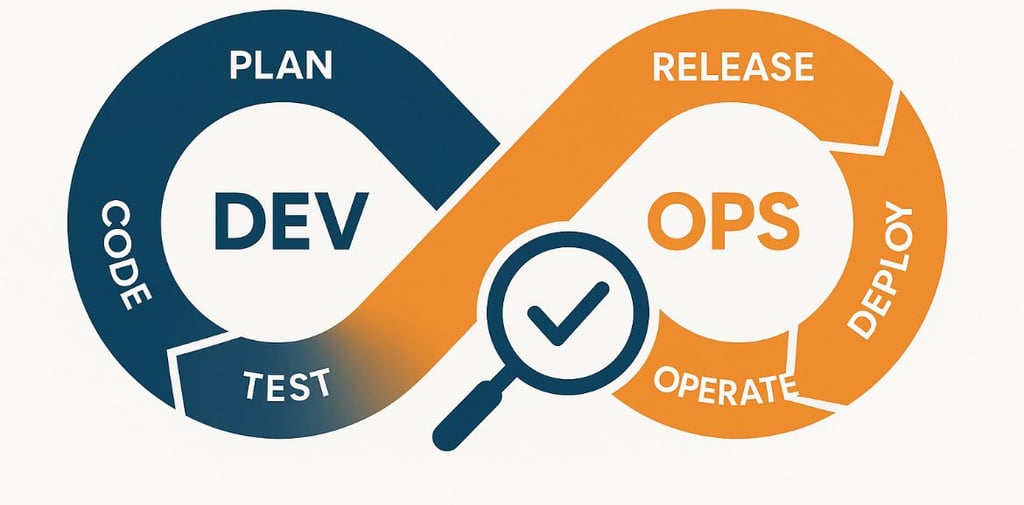
Master Tech skills on the go...
How to Switch from QA to DevOps: A Comprehensive Guide
Discover how to switch from QA to DevOps? Learn a step-by-step guide, tools, and skills to transition smoothly into a high-demand DevOps career, no tech degree required.
TECH CAREER PLAYBOOKS
By OnlineTechSkills Editorial Team
5/18/20256 min read


Transitioning from a Quality Assurance (QA) role into a DevOps position can feel like stepping onto a fast-moving conveyor belt. Both disciplines share a passion for software excellence and reliability, but DevOps expands your impact across development, deployment, and operations. In this guide, we’ll walk you through every concept, tool, and actionable step you need to make that leap confidently.
1. Why Move from QA to DevOps?
As a QA professional, you’re already accustomed to ensuring software quality through testing, automation, and process improvements. DevOps builds on these foundations by integrating development and operations teams, automating delivery pipelines, and fostering a culture of continuous improvement.
Broader impact: Influence not only testing but also code releases, infrastructure, and production stability.
Career growth: DevOps engineers are among the fastest-growing tech careers with entry points even for those starting from scratch, you can redefine your path without a CS degree (The Fastest-Growing Tech Careers You Can Start From Scratch).
Skill synergy: Your QA expertise in automation, scripting, and defect analysis translates directly into writing CI/CD tests, monitoring health checks, and ensuring release quality.
2. Understanding QA vs. DevOps: Core Differences
While both QA engineers and DevOps engineers share a commitment to high-quality software, their focuses and responsibilities diverge across the development lifecycle:
Primary Focus
A QA engineer concentrates on validating and verifying the software to ensure it meets requirements and is free of defects before release. In contrast, a DevOps engineer oversees the entire delivery pipeline building, testing, deploying, and operating applications in production with reliability and speed.Responsibilities
In your QA role, you design test plans, execute manual and automated test cases, log defects, and work closely with developers to reproduce and resolve issues. As a DevOps engineer, you’ll architect and maintain CI/CD pipelines, define infrastructure as code, automate provisioning and deployments, and implement robust monitoring and alerting systems to maintain production health.Toolsets
QA professionals commonly use test frameworks like Selenium, JUnit, or Postman to automate functional, integration, and API testing. DevOps practitioners, on the other hand, leverage tools such as Jenkins or GitLab CI for build and release automation; Docker and Kubernetes for containerization and orchestration; Terraform or CloudFormation for declaring infrastructure; and Prometheus, Grafana, or the ELK Stack for metrics and logging.Collaboration Style
QA engineers often serve as liaisons between development and product teams, ensuring specifications align with actual behavior. DevOps engineers bridge development, QA, and operations teams, fostering a shared responsibility for code quality, deployment frequency, and system uptime. They champion practices like “shift-left” testing bringing testing earlier into the pipeline and “shift-right” monitoring continuously verifying performance in production.
While QA zeroes in on preventing defects, DevOps aims to streamline delivery and maintain system reliability across the full lifecycle.
3. Mapping Your QA Skills to DevOps
Before diving into new technologies, recognize the transferable strengths you already possess:
Automation mindset: QA automation with tools like Selenium or Cypress mirrors writing pipelines in Jenkins or GitLab CI.
Scripting proficiency: If you know Python, JavaScript, or Bash for test scripts, you can automate infrastructure tasks or write deployment scripts.
Attention to detail: QA’s meticulous defect tracking translates to crafting precise IaC definitions or monitoring alerts.
Collaboration: QA often liaises between developers and stakeholders, a key DevOps skill for cross-functional teamwork.
4. Step-by-Step Roadmap to DevOps Mastery
4.1 Assess Your Current Skillset
Inventory tools: List QA tools you use (e.g., Jenkins for automated test runs).
Identify gaps: Note unfamiliar domains, containers, cloud platforms, infrastructure as code (IaC), monitoring.
4.2 Learn DevOps Fundamentals
Version Control: Deepen Git knowledge, branching strategies (GitFlow, trunk-based development).
CI/CD Concepts: Understand build, test, deploy stages; practice creating pipelines in Jenkins or GitLab CI.
Key Reading: “The Phoenix Project” and “The DevOps Handbook” for cultural and process insights.
4.3 Hands-on with CI/CD Tools
Jenkins: Build a sample pipeline that pulls from Git, runs unit tests, builds artifacts, and deploys to a mock server.
GitLab CI / GitHub Actions: Experiment with YAML configurations; add stages for linting, testing, and deployment.
4.4 Master Infrastructure as Code (IaC)
Terraform: Provision virtual machines, networking, and storage on AWS or Azure using declarative code.
AWS CloudFormation: As an alternative, learn AWS-native IaC.
Actionable Step: Create a Terraform module that spins up a three-tier application (web, app, database) in AWS.
4.5 Embrace Containerization and Orchestration
Docker: Dockerize a simple Node.js or Python application; create multi-stage builds to optimize image size.
Kubernetes: Deploy your containerized app on a local cluster (using Minikube or kind). Expose it via Services and Ingress.
Tool Highlight: Helm charts for packaging Kubernetes applications.
4.6 Implement Monitoring and Logging
Prometheus and Grafana: Scrape application metrics, visualize dashboards, set up alert rules.
ELK Stack (Elasticsearch, Logstash, Kibana): Aggregate logs, build search dashboards, create anomaly detection alerts.
Actionable Guide: Instrument your app with Prometheus client libraries for custom metrics.
4.7 Get Comfortable with Cloud Platforms
AWS / Azure / GCP: Pick one major provider. Follow a structured learning roadmap, spin up virtual servers, configure identity and access management, deploy serverless functions.
Related Post: Explore Best Online Platforms to Learn Practical Tech Skills in 2025 to find courses tailored to your chosen cloud provider (Learn Practical Tech Skills).
4.8 Integrate Security (DevSecOps)
Static Analysis Tools: Integrate SonarQube into your CI pipeline to catch code smells and vulnerabilities.
Secrets Management: Use HashiCorp Vault or AWS Secrets Manager to handle credentials securely.
Actionable Step: Set up a CI/CD stage that fails the build if critical vulnerabilities are detected.
4.9 Cultivate Soft Skills and Collaboration
Communication: Host regular “DevOps demos” to show pipeline improvements to stakeholders.
Documentation: Write clear runbooks for deploying, rolling back, and troubleshooting.
Culture: Advocate blameless postmortems to foster continuous learning.
5. Building a DevOps Portfolio
Demonstrating hands-on work is crucial:
GitHub Repository: Showcase multiple repos, for example, “ci-cd-pipeline-demo”, “docker-k8s-sample-app”, “terraform-aws-project”.
Blog Posts or Tutorials: Write about your journey, e.g., “How I Dockerized My First QA Tool”, “Lessons Learned Setting Up Prometheus” (consider using AI-powered learning to draft these posts with ChatGPT: AI-Powered Learning: How to Use ChatGPT as a Personalized Coding Tutor).
Live Demos: Use platforms like GitPod or Play with Docker/Play with Kubernetes to share interactive demos with recruiters.
6. Certifications and Learning Resources
6.1 Key Certifications
AWS Certified DevOps Engineer (Professional)
Certified Kubernetes Administrator (CKA)
HashiCorp Certified: Terraform Associate
6.2 Curated Courses and Tutorials
Roadmap: Follow a 90-day roadmap, for example, the one for front-end but adapt to DevOps skills (Roadmap: Become a Front-End Developer in 90 Days). The same structure, daily sprints, weekly projects works for DevOps learning too.
YouTube Channels and Blogs: CNCF, Jeff Geerling, TechWorld with Nana.
7. Leveraging Transferable QA Expertise
Don’t discard your QA background, amplify it:
Automated Test Suites as Gatekeepers: Use your test frameworks to ensure production-grade quality at every CI/CD stage.
Shift-Left Testing: Introduce performance and security tests early in the pipeline.
Root Cause Analysis: Apply your defect-investigation techniques to production incidents.
8. Networking and Community Involvement
Connecting with peers accelerates learning:
Meetups and Conferences: Join local DevOpsDays events, KubeCon, or cloud provider user groups.
Online Forums: Contribute to Stack Overflow, Reddit’s r/devops, or the Kubernetes Slack channels.
Open Source Contributions: File issues or PRs on CI/CD tools you use, this strengthens your resume and network.
9. Applying and Interview Preparation
9.1 Crafting Your Resume
Highlight projects: “Implemented a Jenkins pipeline reducing deployment time by 70%.”
List DevOps-specific skills: “Docker, Kubernetes, Terraform, Prometheus, ELK.”
Emphasize collaboration: “Led cross-functional DevOps workshops.”
9.2 Mock Interviews and Assessments
Practice whiteboard scenarios: designing a CI/CD pipeline end-to-end.
Hands-on tests: many companies give coding challenges for automation scripts or Terraform tasks.
Behavioral questions: discuss a “blameless postmortem” you led or an incident you resolved.
10. Next Steps and Continued Growth
DevOps is ever-evolving. Keep your skills sharp by:
Exploring AI & Automation: Learn how to integrate LLMs into your workflows—for example, using ChatGPT for generating IaC templates or automating runbook creation (How to Use ChatGPT for Research, Writing, and Brainstorming).
Advanced Topics: Service meshes (Istio), GitOps (Argo CD), chaos engineering (Chaos Monkey).
Cross-Functional Leadership: Aim for Site Reliability Engineering (SRE) roles, or lead a “DevOps Center of Excellence” in your organization.
Conclusion
Switching from QA to DevOps isn’t about shedding your QA identity, it’s about leveraging your testing mindset and automation expertise to own the software lifecycle end-to-end. By following this structured roadmap assessing your skills, mastering core tools, building real-world projects, and engaging with the community you’ll position yourself as a versatile, high-impact DevOps engineer.
Your QA background gives you a unique edge: you know how to break things in testing so they don’t break in production. Now, it’s time to build the pipelines, infrastructure, and culture that keep systems running smoothly around the clock.
Ready to get started? Choose your first project perhaps containerizing one of your existing QA tools with Docker and Kubernetes and share your progress with the DevOps community. Welcome to the DevOps revolution!
Insights
Explore our free and top ranking blogs for in-demand tech skills.
CONTACT US
Support
support@onlinetechskills.com
© 2025. All rights reserved.